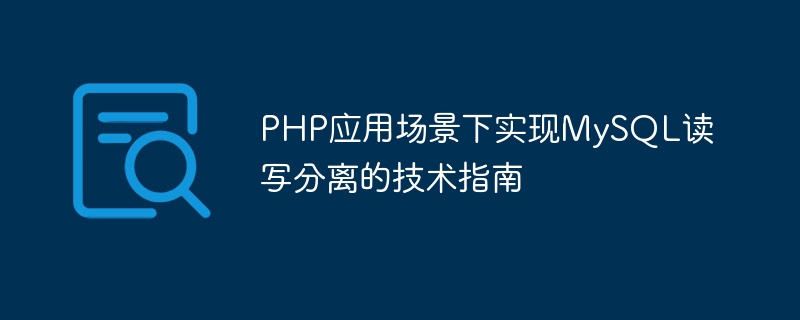Home >Backend Development >PHP Tutorial >Technical Guide to Implementing MySQL Read and Write Separation in PHP Application Scenarios
Technical Guide to Implementing MySQL Read and Write Separation in PHP Application Scenarios
- WBOYWBOYWBOYWBOYWBOYWBOYWBOYWBOYWBOYWBOYWBOYWBOYWBOriginal
- 2024-03-05 10:24:041168browse

PHP is a server-side scripting language widely used in web development, while MySQL is a popular relational database management system. In PHP application scenarios, in order to improve the performance and reliability of the system, MySQL read-write separation technology is usually used to share the pressure on the database server and improve the response speed of the system. This article will introduce how to implement MySQL read and write separation in PHP application scenarios, and give specific code examples.
1. What is MySQL read-write separation
MySQL read-write separation refers to allocating the read operations and write operations of the database to different database servers for processing, thereby sharing the workload of the database server. Pressure, improve the system's concurrency and response speed. Under normal circumstances, there are far more read operations than write operations, so allocating read operations to the slave database of the master database, while write operations are still performed on the master database, can effectively improve the performance of the system.
2. Steps to implement MySQL read-write separation
2.1 Configure the database
First you need to configure master-slave replication in the MySQL database to ensure that the master database and the slave database can Synchronous Data. For specific configuration steps, please refer to MySQL's official documentation or other related tutorials.
2.2 PHP code implementation
Next, you need to implement the logic of reading and writing separation in the PHP code. Normally, this can be achieved by using PDO extensions.
// 主数据库配置
$dsn_master = 'mysql:host=主数据库地址;dbname=数据库名';
$username_master = '用户名';
$password_master = '密码';
// 从数据库配置
$dsn_slave = 'mysql:host=从数据库地址;dbname=数据库名';
$username_slave = '用户名';
$password_slave = '密码';
// 连接主数据库
$pdo_master = new PDO($dsn_master, $username_master, $password_master);
// 连接从数据库
$pdo_slave = new PDO($dsn_slave, $username_slave, $password_slave);
// 查询操作
function query($sql, $pdo) {
$stmt = $pdo->query($sql);
return $stmt->fetchAll(PDO::FETCH_ASSOC);
}
// 读操作
function read($sql) {
global $pdo_slave;
return query($sql, $pdo_slave);
}
// 写操作
function write($sql) {
global $pdo_master;
return query($sql, $pdo_master);
}3. Usage example
The following is a simple usage example. The operations of reading data and inserting data interact with the master database and slave database respectively.
// 读取数据
$result_read = read('SELECT * FROM table_name');
print_r($result_read);
// 插入数据
$result_write = write('INSERT INTO table_name (column1, column2) VALUES (value1, value2)');
print_r($result_write);4. Summary
Through the above steps, we can achieve MySQL read and write separation in PHP application scenarios and improve the performance and reliability of the system. In actual applications, adjustments and optimizations can be made according to specific circumstances, such as adding load balancing, database connection pooling and other technologies to further improve system performance.
Through the above technical guide, I believe readers can better understand and master the methods and implementation methods of realizing MySQL read and write separation in PHP application scenarios. Hope this article is helpful to you.
The above is the detailed content of Technical Guide to Implementing MySQL Read and Write Separation in PHP Application Scenarios. For more information, please follow other related articles on the PHP Chinese website!

